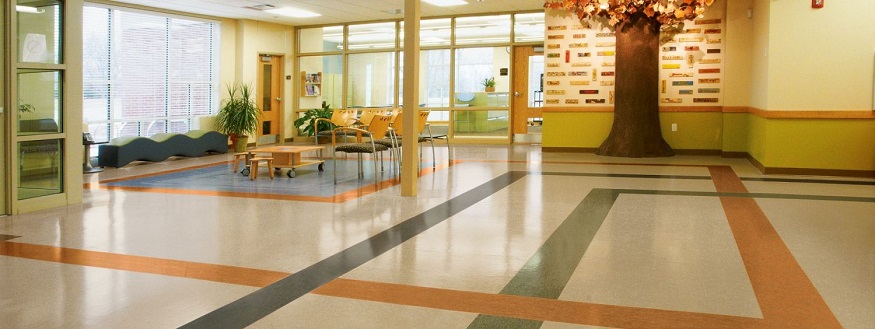Linoleum Flooring for Eco-Friendly Facilities

Photo Credit: Forbo Linoleum Flooring – forbo.com
Linoleum flooring is an eco-friendly product that has become increasingly popular with designers in recent years. It can be the perfect flooring choice for commercial, institutional, and industrial facilities. We especially like it for projects where air quality and sustainability are critical to the project’s success.
Prior to the 1980’s, linoleum was a favorite floor material found in schools, hospitals, and other public buildings. This was the case for many years until the development of vinyl flooring, a plastic product that has superior resistance to moisture. If you are confused about the differences between vinyl and linoleum products, learn the differences here.
In recent years, consumers are increasingly looking for environmentally-friendly products and are willing to consider linoleum over vinyl. For instance, linoleum is now seen as a great choice for projects that are pursuing LEED certification. These projects are focused on products that are healthy, highly energy-efficient, and cost-efficient.
In addition to its eco-friendly profile, linoleum offers a number of other attractive properties. We like linoleum’s resiliency, durability, and easy-care for our clients. Also, because of modern manufacturing processes, linoleum now offers us an attractive variety of colors and styles from which to choose.

Photo Credit: Armstrong Linoleum Flooring – armstrongflooring.com
What is Linoleum?
What IS linoleum? Linoleum is a resilient, eco-friendly flooring material made from all-natural, renewable materials. In contrast, vinyl flooring is a resilient material made from plastic, a petroleum product.
Linoleum is made primarily from linseed oil, a naturally occurring substance extracted from flax seeds. The linseed oil is mixed with cork powder, tree resins, wood flour, and pigment to make linoleum. Sometimes, limestone dust is added for increased hardness and durability. In some cases, a protective coating or wax may be added to prevent surface scratching and fading.
Linoleum flooring comes in a rainbow of colors in sheets, tiles, or planks and has a jute or canvas backing. To see the various options, you can check out these reputable linoleum manufacturers: Forbo (Marmoleum) and Armstrong Flooring.
Advantages and Disadvantages of Linoleum
Are you considering using linoleum flooring for your facility or new project? Here are some good reasons to do so:
- Eco-Friendly – It’s made with renewable materials that are biodegradable after the product’s useful life. A portion of the content of linoleum may also be from recycled materials. Sustainability is probably the most compelling reason for using linoleum flooring over vinyl.
- Low VOC emissions – Linoleum emits no- or low-levels of VOCs. Concentrations of VOCs are believed to have long-term negative health effects.
- Resilient – Linoleum is comfortable underfoot. It compresses and then bounces back, so it’s easy on your feet and joints.
- Durable – Linoleum is known for its durability, lasting 25-40 years. Linoleum flooring withstands heavy foot traffic and rolling loads. Because of this, it is typically warranted for 25 years.
- Colorful – It’s really colorful! Designers love the many color and pattern possibilities, especially when using tiles.
- Colorfast – The color goes through the entire product – the pigment and patterns are not just printed on the surface. The pigment is incorporated throughout the thickness of the material, so scratches are not so apparent.
- Easy Care – It’s easy-peasy! Just sweep and damp mop and you’re done! Many linoleum products have a protective coating that resists scratching and fading. If it is not sealed, it should be waxed every year or so.
Although we recommend linoleum flooring for many applications, it does have a few limitations:
- Like all resilient flooring, it’s subject to scratches, dents, and cutting.
- The finish may darken in sunlight in a process called “ambering”.
- It’s water-resistant, but still susceptible to damage from moisture – avoid using it in high humidity and wet areas.
- There’s a temporary smell from linseed oil that lasts for a few weeks after installation.
- Like most flooring materials, it may be slippery when waxed or washed.
- Linoleum has a higher cost than vinyl, but that is offset by its longer life.
Installing Linoleum
Linoleum flooring is fairly easy to install. You can glue down sheets of linoleum by applying the recommended low VOC or water-based adhesive to a solid, level subfloor. Tiles and planks are also available in a snap-together option. Since linoleum is stiffer than vinyl, the installation is a bit trickier – if you want to install it yourself, planks and tiles may be a better choice over sheet material. Refer to the manufacturer’s installation recommendations.
Consider using linoleum flooring for your existing facility or new project. It’s an eco-friendly product that’s an especially good choice where air quality and sustainability are critical to the project’s success. Linoleum can be the perfect flooring choice for your commercial, institutional, or industrial facility.



